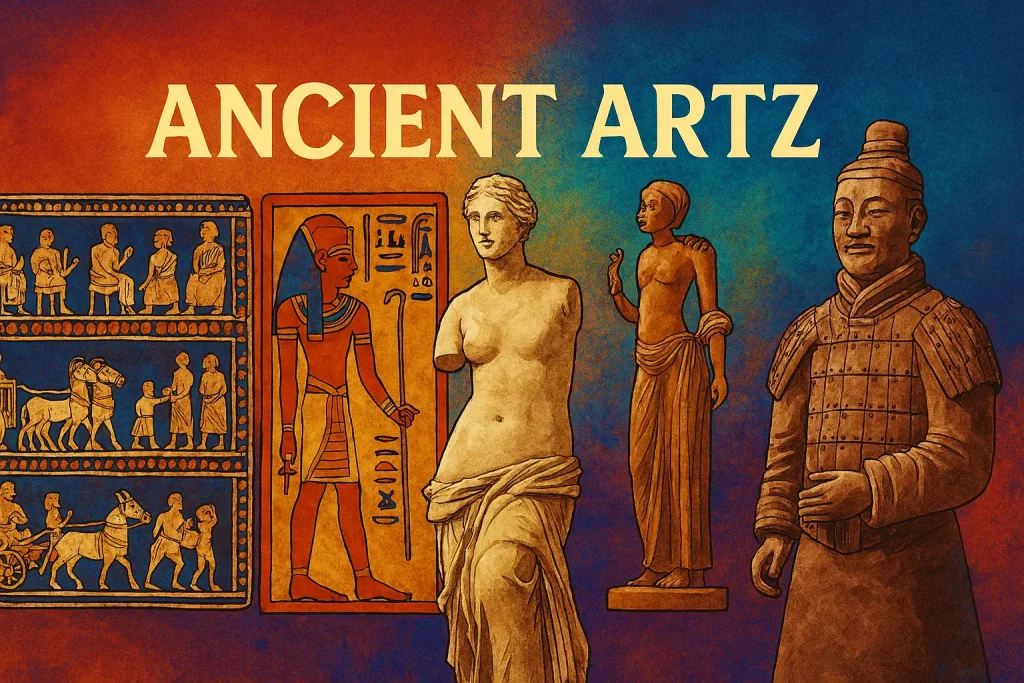
From the caves of early humans to the monumental temples of empires, ancient artz speak across millennia. This timeless visual language, filled with religious symbolism, sacred iconography, and cultural resonance, forms the foundation of what we understand as art today.
Whether it’s the elegance of Greek pottery, the mystery of Egyptian hieroglyphics, or the fierce presence of the Chinese Terracotta Army, ancient art captures emotion, authority, and innovation. Each piece is not just decoration—it’s a narrative carved in stone, molded in bronze, or painted on sacred walls.
What Is Ancient Artz?
Ancient Artz refers to the visual and creative expressions of early civilizations. Spanning prehistoric cave paintings to the classical works of Rome, it includes sculpture, architecture, murals, and decorative objects rooted in cultural tradition, belief systems, and identity.
This art wasn’t created for galleries. It lived in temples, tombs, palaces, and streets. It shaped rituals, influenced governance, and served as a bridge between the physical and spiritual world.
Also Read: https://fizzymag.co.uk/jonathonspire/
The Origins of Visual Expression in Prehistoric Times
Before civilizations, art was already blooming. Prehistoric art—like the cave paintings in Lascaux and Altamira—marked the earliest known attempts to represent the human experience visually. These primitive art forms, featuring animals, hunting scenes, and symbols, communicated stories and beliefs in ways words never could.
Stone carvings and handprints reveal the dawn of early human expression. They offer insight into the Bronze Age creativity that fueled all future art. These were more than visuals—they were declarations of identity, survival, and spirituality.
Symbolism and Functionality in Mesopotamian Art
Mesopotamia—the “cradle of civilization”—pioneered one of the earliest known art forms. The iconic Standard of Ur, adorned with inlaid stones and shells, displays scenes of war and peace with compelling balance. These artworks were often practical, serving as seals, tablets, or ritual objects.
Cuneiform script, etched into clay tablets, merged art and language into a sacred whole. Mesopotamian sculpture often emphasized authority, deities, and cosmic order, reflecting the importance of religious symbolism in art.
Sacred Geometry and Iconography in Ancient Egyptian Art
Egyptian art is instantly recognizable for its symmetry, symbolism, and eternal themes. Rich in sacred geometry and divine alignment, every figure and form had a purpose. From gods to pharaohs, each image was meticulously designed to preserve spiritual order, or ma’at.
Hieroglyphics weren’t just letters—they were art. Each symbol held sound, image, and meaning. From temple murals to the massive monuments like the pyramids, art in Ancient Egypt was a holy language of the cosmos.
Mythology, Idealism, and Innovation in Ancient Greek Art
1. The Influence of Gods and Heroes
Greek art reflected the grandeur of mythology—Zeus, Athena, and Apollo appeared frequently, depicted with idealized perfection. This was not only spiritual but philosophical, an expression of humanity’s potential.
2. From Marble to Movement
Sculptors like Phidias, who crafted the monumental Athena Parthenos and Zeus statue, set new standards of realism and emotion. These statues were more than figures—they were embodiments of divine beauty.
3. Everyday Life in Artistic Form
Greek pottery painted vivid scenes of sports, battles, and banquets. It was both decorative and functional—art infused with daily reality, turning classical antiquity artwork into a living chronicle.
Narrative Realism and Daily Life Depictions in Roman Art
Romans inherited much from the Greeks but introduced greater realism and storytelling. The frescoes of Pompeii vividly depict markets, homes, and mythology. Roman frescoes used perspective and vibrant pigments to create immersive scenes.
Sculpture in the Roman Empire celebrated emperors, military victories, and philosophical ideals. Mosaics adorned floors and walls, while monumental architecture like the Colosseum served as both entertainment and imperial propaganda.
Sophistication of Early South Asian Sculptures and Bronzes
The Indus Valley Civilization stunned the world with the Dancing Girl of Mohenjo-daro, a bronze statue full of rhythm and life. This was a society deeply rooted in artistry and advanced metallurgical skills.
Later, Hindu temples and Buddhist art introduced exquisite stone carvings and temple murals. These works emphasized cosmic order, devotion, and the spiritual journey, offering sacred iconography wrapped in regional elegance.
Ritual Vessels and Imperial Legacy in Ancient Chinese Art
Under the Shang Dynasty, bronze ritual vessels reached unparalleled refinement. Designed for ancestral rites, they featured intricate motifs of dragons and mythical beasts, representing power and the afterlife.
The Terracotta Warriors, commissioned by Emperor Qin Shi Huang, guarded his tomb with silent vigilance. Each life-sized figure holds a unique expression—an awe-inspiring feat of ancient artistic techniques and imperial vision.
The Influence of Religion and Spiritual Beliefs in Ancient Art
Religion was the soul of ancient art. It dictated form, purpose, and placement. Whether a temple relief, a sacred sculpture, or a burial object, art acted as a divine intermediary.
From Ziggurats in Mesopotamia to sacred texts and idols in Ancient India, religious symbolism in art shaped how civilizations saw their gods—and themselves. Art was faith carved in stone, molded in bronze, and painted with devotion.
Material Techniques and Tools Used by Ancient Artists
Artists of the past were engineers of beauty. They ground pigments from minerals, carved tools from bone and stone, and mastered metallurgy to mold lasting masterpieces.
Techniques varied—from fresco painting in Rome to lost-wax casting in India. Their tools may have been simple, but their results were sophisticated and timeless.
The Role of Art in Politics, Power, and Propaganda
1. Glorifying Kings and Rulers
Art was a powerful tool of leadership. Pharaohs were immortalized in colossal statues. Roman emperors appeared on coins and monuments to symbolize authority.
2. Architecture as Power
Monumental architecture like pyramids, temples, and amphitheaters demonstrated imperial wealth and divine right. These structures were not just grand—they were messages of dominance.
3. Visual Narratives and Control
Murals, sculptures, and coins carried political messages. Art shaped public perception, reinforced hierarchy, and displayed control across vast empires.
Cultural Exchange and Artistic Syncretism Across Empires
Trade, conquest, and migration allowed art styles to blend across borders. Greco-Buddhist art in ancient Afghanistan, Roman-inspired mosaics in North Africa, and Chinese silk motifs in Persia are proof.
This fusion of styles gave rise to innovative forms—art that was both local and global. It reflected a shared human desire for beauty, meaning, and expression.
Preservation, Archaeological Discoveries, and Modern Insights
1. The Role of Archaeology
Modern archaeological discoveries—from Pompeii to the tombs of China—have reshaped our understanding of ancient civilizations. Each find is a portal to lost worlds.
2. Museums and Scientific Analysis
Cutting-edge tools allow experts to reconstruct how ancient art was made and used. From CT scans to pigment analysis, we’re learning more about the hands and minds behind the masterpieces.
Lesser-Known Civilizations and Their Hidden Artistic Legacies
From the Nok terracottas in Nigeria to the petroglyphs of Val Camonica in Italy, lesser-known societies produced dazzling artworks. Their contributions remain under-celebrated but profoundly influential.
These hidden gems expand the timeline and territory of cultural art history. They remind us that creativity is universal and eternal.
Ancient Art as a Historical Record of Human Evolution
Art is humanity’s oldest diary. It records our fears, hopes, gods, and daily life. It’s how we preserved our stories before the written word.
Through visual clues and sacred motifs, ancient art provides a rich, non-verbal timeline of our evolution—culturally, intellectually, and spiritually.
Timeless Influence of Ancient Art on Contemporary Design
Modern architecture, sculpture, and fashion often draw from ancient styles. The balance of Egyptian symmetry, the grace of Greek statues, and the boldness of Roman forms continue to inspire.
Designers and artists echo the past in modern language—because the genius of ancient art never faded. It merely evolved.
Technological and Digital Reconstructions of Ancient Masterpieces
With 3D scanning and AR tools, ancient art is being digitally reborn. Museums create immersive experiences, letting users “walk through” Pompeii or examine the Terracotta Warriors up close.
These tools don’t just preserve—they educate, inspire, and revive long-lost beauty for new generations.
Top Museums and Exhibits Housing Ancient Artifacts Worldwide
- The British Museum (London)
- The Louvre (Paris)
- The Met (New York)
- The Egyptian Museum (Cairo)
- The National Museum of China (Beijing)
Each museum houses priceless treasures—from the Standard of Ur to the Dancing Girl. They safeguard humanity’s creative heritage.
Controversies Around Restitution and Ownership of Ancient Art
Ownership of ancient artifacts sparks passionate debate. Many works in Western museums originated from colonial excavations or wartime seizures.
Today, the global call for repatriation grows louder. The discussion isn’t just legal—it’s about ethics, respect, and healing historical wounds.
FAQs
What is the oldest known piece of ancient art?
Cave paintings from Indonesia and France, dating back over 40,000 years, are among the oldest known artworks.
Why is ancient art important today?
It connects us to our roots, reveals cultural values, and continues to inspire modern art, architecture, and design.
What materials did ancient artists use?
Stone, bronze, clay, pigments from minerals, and precious metals like gold and silver.
Where can I see ancient art today?
Top museums worldwide or through virtual exhibits from institutions like the British Museum and Google Arts & Culture.
Conclusion
Ancient artz is more than an aesthetic—it’s the story of humanity, carved and painted across millennia. It’s divine, functional, political, emotional—and always powerful.
Through these timeless masterpieces, early civilizations remind us of who we are, what we believed, and how we saw the world. And in doing so, they offer an everlasting source of inspiration, truth, and beauty.





